
Beyond the Weight Limit: How to Choose the Best Electric Bike for 300–400 lb Person
Finding the Right Electric Bike When You Weigh 300-400 Pounds
Shopping for electric bikes can feel tough. Many of us who weigh between 300 and 400 pounds feel forgotten by bike makers. Most bikes look weak, weight limits don't make sense, and good information is hard to find. We get how frustrating this can be.
The good news is simple: great bikes exist for heavier riders. Finding the right bike means understanding what makes an e-bike truly strong, not just reading product lists. This guide will teach you what you need to know to find the best electric bike for a 300 lb person. You'll learn to choose with confidence. We'll explain the technical stuff and show you what really matters for safety, strength, and fun rides.
Understanding E-Bike Weight Capacity
You'll see "Max Load" or "Weight Capacity" on every bike spec sheet. This number matters, but most people don't understand what it really means. Looking deeper than just the number helps you make smart choices. This knowledge builds confidence when picking your bike.
What "Max Load" Really Means
The "Max Load" number isn't just about your body weight. It covers everything the bike needs to carry safely. The math is easy: Total Weight = Your Weight + Bike's Weight + Cargo Weight (groceries, backpack, accessories)
Bike makers test frames, wheels, and parts under stress to find this number. They add safety margins to handle bumps and sudden forces. Don't think this safety buffer means you can go over the limit. It protects against single hard hits, not constant overloading. Make sure you know if the number includes just payload (rider + cargo) or total load (rider + cargo + bike weight).
What Happens When You Ignore Weight Limits
Going over the weight limit creates serious safety and money problems, not just frame damage.
- Braking distance gets much longer. Brakes made for 250 pounds total will struggle to stop 400 pounds, especially going downhill. This creates dangerous situations.
- Parts wear out fast. Spokes break more often, tire sides can fail, and suspension parts die early. You'll spend lots of money on constant repairs.
- The bike becomes hard to control and unsafe. Overloaded frames bend in weird ways, making steering difficult at speed or around turns.
- Your warranty becomes worthless. If parts break because you exceeded the weight limit, the company won't pay for fixes. This costs you serious money.
The 5 Pillars of Heavy-Duty Ebikes
Shopping for an electric bike for 400 lb person means checking specific features. These five pillars create safe, reliable, and fun rides. Use this as your shopping checklist when comparing different models.
Pillar 1: The Frame
The frame holds everything together, so it must be strong. Look for high-quality aluminum alloy frames like 6061 or 7005. Check the details carefully. Do you see thick, oversized tubes? Are there extra metal pieces called gussets strengthening joints around the head tube and bottom bracket? These show the frame was built for heavy-duty use.
Frame shape affects comfort and safety too. Step-thru frames work great for many heavier riders. You don't need to swing your leg over a high bar, making getting on and off much easier and safer, especially if you're not flexible or stopped at lights.
Pillar 2: The Motor
Power matters, but not all power works the same way. Companies love advertising high wattage numbers, but torque measured in Newton-meters (Nm) matters more for us. Torque provides the twisting force that gets you moving from stops and pulls you up hills. Riders over 300 pounds need motors with at least 80 Nm of torque. Less power feels slow and struggles on hills.
You'll find two main motor types: hub drives (in the wheel center) and mid-drives (at the pedals). Strong hub motors work well and are common in this category. Mid-drive motors feel more natural when pedaling and use the bike's gears better for climbing, but both types work great if they have enough torque.
Pillar 3: The Brakes
Brakes are your most important safety feature. Heavy-duty e-bikes need 4-piston hydraulic disc brakes only. Here's what that means. "Hydraulic" uses fluid pressure, giving more stopping power with less hand effort than cable brakes. "4-piston" means four pistons in the brake part push the pads against the rotor. Four-piston brakes give better power and handle heat better than standard 2-piston brakes for heavy loads, preventing brake fade on long downhills. Check rotor size too. Bigger rotors (180mm or better yet 203mm) provide more leverage and handle heat better, keeping stopping power consistent when you need it.
Pillar 4: The Wheels and Tires
Wheels carry all the weight, and standard e-bike wheels often can't handle the job. Find wheels with more spokes, usually 32 or 36. More importantly, look for thicker spokes like 12-gauge or 13-gauge. These are much stronger and resist breaking under heavy rider stress.
Fat tires (4 inches or wider) are perfect for heavier riders. They give several key benefits. The wide contact area provides great stability and grip on different surfaces. The large air volume works like suspension, smoothing bumps and vibrations for much more comfortable rides. Experts note that wider tires improve comfort and stability significantly, making this upgrade valuable for any rider.
Pillar 5: The Battery
The battery powers your rides, and its capacity is measured in Watt-hours (Wh). Higher Wh numbers mean longer possible range. Heavier riders use more motor power to speed up and climb hills, draining batteries faster. Small batteries lead to range worry and disappointment. We suggest batteries with at least 720Wh capacity as a good starting point. For long rides or very hilly areas, look for bikes with nearly 1000Wh or dual-battery systems.
| Rider Weight / Terrain | Minimum Motor Power | Minimum Torque | Recommended Battery |
|---|---|---|---|
| 300 lbs / Flat City | 750W | 80 Nm | 720 Wh |
| 350-400 lbs / Hilly | 1000W (Peak) | 95+ Nm | 960+ Wh (or Dual Battery) |
Real-World Riding Tips
Owning the best electric bike for a 300 lb person goes beyond buying the right model. Heavier riders stress bikes differently, so staying ahead of maintenance and doing pre-ride checks keeps your experience safe and long-lasting. This advice comes from real experience.
A Heavier Rider's Checklist
Simple checks before every ride prevent big problems later. This isn't general advice; it's critical for us.
- Tire Pressure is Everything: This is your most important check. Proper inflation protects heavier riders from pinch flats (when the tube gets pinched against the rim) and keeps the bike rolling smoothly. Under-inflated tires feel slow and are dangerous. Use a floor pump with a gauge and inflate to the pressure shown on your tire's side.
- Brake Check: Squeeze both brake levers hard. They should feel solid and stop the wheel completely. They shouldn't feel spongy or pull all the way to the handlebar.
- Axle Check: Look at the levers on quick-release skewers or bolts on thru-axles. Make sure they're tight and secure. Loose wheels are immediately dangerous.
Accelerated Maintenance
Expect some parts to wear faster than they would for lighter riders. This is normal and expected.
- Brake Pads: You'll wear through brake pads quicker because of higher stopping forces. Learn to check them for wear—most have wear indicator lines. Plan to replace them more often.
- Spoke Tension: After your first 100 miles on a new bike, have your wheels checked and "trued" (straightened) by a bike mechanic. Spokes settle under load, and re-tensioning creates much stronger, more durable wheels long-term.
- Chain and Drivetrain: Your chain, cassette, and chainrings work under more stress. Keep the drivetrain clean and well-oiled to make it last longer and shift smoothly.
Community Wisdom
You're not alone in this journey. Active online communities of e-bike riders love sharing their experiences. Forums and groups provide valuable honest, long-term feedback on specific models you might consider. Reading discussions from riders in similar situations gives insights you won't find in marketing materials.

Your Journey Starts Here
You now have the knowledge to see past marketing hype and spot truly capable e-bikes. Finding the perfect ride means more than just finding high weight limits; it's understanding how components work together to provide safe, powerful, and durable experiences. Focusing on the five pillars lets you confidently evaluate any bike and make choices that serve you well for years. E-biking freedom and joy are available to everyone, and your adventure starts now.
Your Final Checklist Before You Buy:
- Confirm the bike's real weight capacity, understanding it includes rider, bike, and cargo.
- Demand 4-piston hydraulic disc brakes with large (180mm+) rotors.
- Focus on high motor torque (80+ Nm) over simple wattage numbers.
- Check the frame for reinforcements and look for high-spoke-count wheels (36 spokes).
- Don't accept small batteries; aim for 720Wh minimum.
Frequently Asked Questions
1. What's the difference between payload capacity and total weight capacity?
Payload capacity refers to just the rider and cargo weight the bike can carry. Total weight capacity includes the rider, cargo, and the bike's own weight combined. Always clarify which measurement the manufacturer is using to avoid confusion and ensure you stay within safe limits.
2. Can I modify a regular e-bike to handle more weight instead of buying a heavy-duty model?
Modifying a regular e-bike for heavy-duty use isn't recommended and can be dangerous. The frame, wheels, and components are engineered as a system for specific weight limits. Upgrading individual parts without changing the frame foundation creates weak points that can fail catastrophically.
3. How much should I expect to spend on a quality heavy-duty e-bike?
Quality heavy-duty e-bikes typically cost between $2,000 and $4,000. While this seems expensive, remember that cheaper bikes often fail quickly for heavier riders, leading to costly repairs and safety issues. Investing in proper components upfront saves money and ensures safety long-term.
4. Do I need special insurance or registration for a heavy-duty e-bike?
Most states treat e-bikes like regular bicycles and don't require registration or special insurance. However, given the higher value of heavy-duty e-bikes, consider adding them to your homeowner's or renter's insurance policy. Check your local laws as regulations vary by location.
5. How can I test ride an e-bike before buying if I'm concerned about weight limits?
Contact local dealers directly and explain your needs. Many shops that sell heavy-duty e-bikes understand heavier riders' concerns and will accommodate test rides. Some manufacturers also offer trial periods or satisfaction guarantees. Don't buy without testing, as comfort and fit are crucial for long-term satisfaction.










































Leave a comment